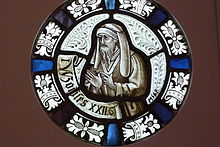Moses (Museum Schnütgen)
The representation of Moses is a fragment of a leaded glass window created by an unknown artist in the 15th century. The disc came to the Museum Schnütgen in Cologne in 1932 and has the inventory no. M 168.
origin
The disc with a diameter of 22 cm probably comes from a Cologne workshop. It was installed with others in 1906 in a tracery window in the chapel of the Starkenberg house on Cologne's Heumarkt . The original origin is unknown.
description
In the circular medallion, the half-figure of a disputing prophet (see hand movement) can be seen, who is dressed in oriental costume. The background of the figure consists of a thin tendril pattern and a border (from a later period) with ornamental shapes surrounds the medallion. The following inscription can be seen in the foreground: “I Moijses XXII. 6. ”This Bible verse reads:“ He also took the wood for the burnt offering and laid it on his son Isaac ”( Genesis ). The sacrifice of Isaac was seen as a model for Christ carrying the cross . In the Biblia pauperum this representation was part of the canon.
In the beard hair you can clearly see strands made using the negative technique and lines of light can be seen on the bridge of the nose, cheekbones and lids.
literature
- Brigitte Lymant: The stained glass of the Schnütgen Museum . Schnütgen Museum, Cologne 1983.
